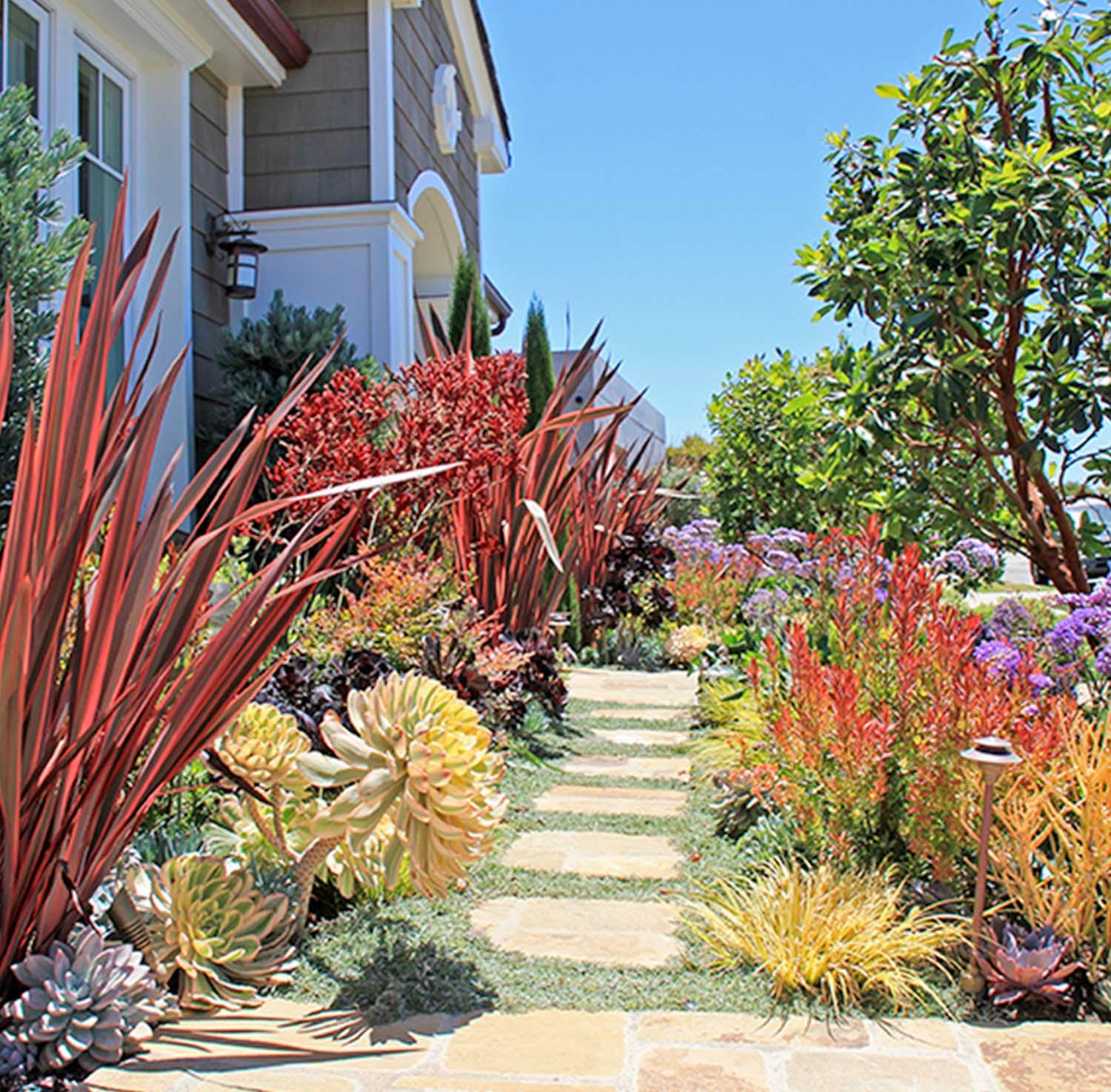Are you ready to transform your outdoor space into a vibrant, thriving garden that stands strong under California’s sun? Choosing the right plants can make all the difference in creating a landscape that not only looks stunning but also saves you time, water, and effort.
Whether you want lush greenery, colorful blooms, or low-maintenance shrubs, this guide to the best landscaping plants for California will help you pick varieties perfectly suited to your local climate. Keep reading to discover how to make your garden both beautiful and sustainable, turning your yard into the envy of the neighborhood.
Your dream garden starts here!
Native Plants For California Gardens
Native plants bring life and balance to California gardens. They adapt well to local climates and soil. These plants need less water and care than exotic species. Using natives helps support local wildlife and bees. They create beautiful, sustainable landscapes year-round.
Drought-tolerant California Natives
California’s dry summers demand tough, drought-resistant plants. Manzanita offers red bark and small pink flowers. California poppies add bright orange color in spring. Sagebrush and California fuchsia thrive with little water. These plants reduce water use and survive heat well.
Flowering Shrubs And Perennials
Flowering shrubs and perennials bring color and texture. Ceanothus, or California lilac, blooms blue or white flowers. Toyon, also called Christmas berry, shows red berries in winter. Matilija poppy has large white flowers that resemble a poppy. These plants attract birds and pollinators to your garden.
Trees That Thrive In California Climate
Some native trees grow strong in California’s varied climates. Coast live oak provides shade and habitat for wildlife. California sycamore has large leaves and a white bark. Valley oak grows tall and lives for hundreds of years. Planting native trees improves air quality and soil health.
Heat-resistant Plant Varieties
California’s hot climate calls for plants that can handle intense heat and dry conditions. Heat-resistant plant varieties thrive with less water and stay vibrant under the sun. Choosing these plants helps maintain a beautiful garden without much effort. These varieties reduce water use and keep your landscape green and lively through warm seasons.
Perennials That Love The Sun
Perennials that enjoy full sun and heat bring long-lasting color to your garden. Plants like California poppy, blanket flower, and yarrow do well in hot spots. They need little water once established and bloom repeatedly. These perennials attract pollinators and add texture with their bright flowers.
Shrubs Suited For Hot Summers
Shrubs that tolerate heat add structure and shade to your yard. Toyon, manzanita, and ceanothus are popular choices for warm climates. These shrubs survive dry spells and grow dense foliage. They also support local wildlife and require minimal care.
Ground Covers For Warm Areas
Ground covers help control soil temperature and reduce water loss in hot areas. Plants like creeping rosemary, purple ice plant, and sedum spread easily. They form a green carpet that prevents weeds and protects soil. These ground covers keep your landscape cool and attractive.
Low-water Landscaping Plants
California’s dry climate calls for landscaping plants that thrive with little water. Low-water landscaping plants save water and reduce garden maintenance. These plants stay healthy with minimal irrigation. They also add beauty and texture to outdoor spaces. Choose plants that suit California’s varied regions for best results.
Succulents And Cacti Options
Succulents and cacti store water in their leaves and stems. This makes them perfect for dry gardens. Popular succulents include agave, aloe, and echeveria. They come in many shapes and colors. Cacti like golden barrel and prickly pear add a desert feel. These plants need full sun and well-drained soil. They require very little water once established.
Mediterranean-style Plants
Mediterranean plants are adapted to hot, dry summers. Lavender, rosemary, and sage thrive in California’s climate. These plants have fragrant leaves and attract pollinators. Olive trees and Italian cypress add height and structure. Mediterranean plants prefer sunny spots and dry soil. They require less water than typical garden plants.
Water-wise Grasses And Ferns
Water-wise grasses and ferns add movement and softness to landscaping. Blue grama and deer grass are drought-tolerant options. They tolerate heat and need little water. Some ferns, like the California native sword fern, survive dry spells. These plants prefer partial shade to full sun. They add green texture without heavy water needs.
Evergreens For Year-round Appeal
Evergreen plants bring constant color and texture to California gardens. Their leaves stay green throughout the year. This quality makes them perfect for creating lasting beauty. Evergreens provide structure, privacy, and visual interest in all seasons. They also support local wildlife by offering shelter and food. Choosing the right evergreen plants enhances your landscape’s charm and function.
Fast-growing Evergreen Shrubs
Fast-growing evergreen shrubs fill empty spaces quickly. They create a lush green backdrop in months. Some popular choices include California lilac and manzanita. These shrubs tolerate drought and heat well. They need little water once established. Fast growth helps hide fences or walls fast. Shrubs like these make gardens look full and vibrant.
Columnar Trees For Privacy
Columnar evergreen trees grow tall and narrow. They fit well in small or tight spaces. Arborvitae and Italian cypress are great examples. These trees form natural privacy screens quickly. Their dense foliage blocks views and noise effectively. They add vertical interest without taking much ground area. Columnar trees help create private outdoor rooms easily.
Fragrant Evergreen Plants
Fragrant evergreen plants add scent and beauty. Rosemary and lavender bloom with lovely aromas. Their scent attracts pollinators like bees and butterflies. These plants thrive in California’s dry climate. They require minimal care and water. Fragrant evergreens make gardens inviting and lively. They also work well in containers or borders.
Colorful Flowering Plants
Colorful flowering plants bring life and vibrancy to California landscapes. Their bright blossoms brighten gardens and outdoor spaces. These plants thrive in California’s diverse climates. They offer a wide range of colors, shapes, and sizes. Choosing the right flowering plants can create stunning visual appeal year-round.
Seasonal Bloomers
Seasonal bloomers offer color during specific times of the year. Spring bloomers include poppies, lupines, and California lilacs. Summer brings bright sunflowers, zinnias, and marigolds. Fall bloomers like chrysanthemums and asters add warm tones. These plants help maintain vibrant landscapes through every season.
Attracting Pollinators
Flowering plants attract bees, butterflies, and hummingbirds. Native plants like California fuchsia and milkweed support local pollinators. They boost garden health and increase plant reproduction. Choose plants with nectar-rich flowers to encourage visits. Pollinators make gardens lively and help ecosystems thrive.
Mixing Colors And Textures
Combining different colors creates eye-catching contrasts. Pair bold reds with soft pinks or bright yellows with deep purples. Mixing textures adds depth and interest. Use plants with fine leaves alongside broad, smooth foliage. Varied shapes and sizes make landscapes dynamic and inviting.

Credit: www.rogersgardens.com
Plants For Coastal And Inland Areas
California’s diverse climate zones require careful plant choices for landscaping success. Coastal areas face salty air and strong winds. Inland regions often deal with dry heat and lower humidity. Selecting the right plants helps gardens thrive in these varied environments. Understanding plant needs ensures lasting beauty and health in your landscape.
Salt-tolerant Coastal Choices
Coastal gardens need plants that resist salt spray and wind. California lilac (Ceanothus) offers vibrant blue flowers and tough leaves. Beach strawberry (Fragaria chiloensis) grows low and spreads easily. California poppy (Eschscholzia californica) adds bright orange color and tolerates salty soil. These plants survive harsh coastal conditions and add charm to seashore landscapes.
Plants For Dry Inland Gardens
Inland gardens require drought-tolerant plants that handle heat well. Manzanita (Arctostaphylos) has red bark and evergreen leaves. Deer grass (Muhlenbergia rigens) grows tall and adds texture. Toyon (Heteromeles arbutifolia) produces red berries and attracts birds. These plants save water and thrive in dry soils typical of inland California.
Adjusting Plant Selection By Zone
California’s climate zones range from coastal cool to hot inland valleys. Choose plants that match your specific zone. Coastal zones need salt-tolerant species with wind resistance. Inland zones require drought-resistant and heat-tolerant plants. Use local nursery advice or USDA zone maps. Proper plant selection reduces maintenance and improves garden success.
Using Native Plants For Habitat
Native plants hold a special place in California’s landscape. They thrive in local soil and weather without much help. Using native plants supports the environment and creates a natural habitat. These plants attract and sustain local wildlife, helping to keep ecosystems balanced and healthy.
Planting native species reduces the need for extra water and chemicals. This makes gardens easier to care for and better for the planet. Native plants also add beauty with their unique shapes and colors. They bring a natural feel to any outdoor space.
Supporting Local Wildlife
Native plants provide food and shelter for birds, bees, and butterflies. These animals depend on local plants for survival. Wildflowers like California poppies attract pollinators. Shrubs such as manzanita offer berries for birds to eat. Planting native species helps keep wildlife close to home.
Fire-resistant Plant Options
Some native plants resist fire better than others. Using these plants can protect your home in wildfire-prone areas. California lilac and toyon are good choices. They have thick leaves and hold moisture well. Fire-resistant plants slow down flames and reduce fire damage.
Creating Bird-friendly Spaces
Birds need plants for food, nesting, and cover. Native trees and shrubs make perfect bird habitats. Oaks and elderberries attract many bird species. Adding water features and bird feeders enhances the space. A bird-friendly garden brings life and sound to your yard.

Credit: www.rogersgardens.com
Maintaining California Gardens
Maintaining a garden in California requires special care due to its unique climate. The dry seasons and warm temperatures affect plant health and growth. Proper garden maintenance helps plants thrive and keeps your landscape beautiful all year round.
Watering Tips For Dry Seasons
Water plants early in the morning or late in the evening. This reduces water loss due to evaporation. Use drip irrigation to deliver water directly to roots. Avoid overwatering, which can harm plants and waste water. Group plants with similar water needs together for efficient watering.
Soil Preparation And Mulching
Prepare soil by mixing organic matter to improve drainage and nutrients. Mulch around plants helps retain moisture and control weeds. Use natural mulches like bark or straw for best results. Mulching also keeps soil temperature stable during hot days. Renew mulch yearly to maintain its benefits.
Pruning And Pest Management
Prune plants regularly to remove dead or damaged branches. This promotes healthy growth and improves air circulation. Check plants often for signs of pests or diseases. Use natural pest control methods, such as introducing beneficial insects. Avoid harsh chemicals that can harm your garden’s ecosystem.

Credit: www.thegoldhive.com
Frequently Asked Questions
What Are The Best Drought-tolerant Plants For California?
Drought-tolerant plants like California lilac, agave, and succulents thrive in California’s dry climate. They require minimal water and maintenance, making them eco-friendly and cost-effective choices for landscaping.
Which Native Plants Thrive In California Gardens?
Native plants such as Toyon, Manzanita, and California poppy adapt well to local soil and climate. They support local wildlife, reduce water use, and enhance the natural beauty of California landscapes.
How To Choose Plants For California’s Hot Summers?
Select heat-tolerant plants like lavender, rosemary, and sage. These plants withstand high temperatures and require less irrigation, making them ideal for maintaining vibrant gardens during California’s hot summers.
Can Landscaping Plants Improve California’s Soil Quality?
Yes, plants like clover and lupine fix nitrogen, enriching California soils naturally. Incorporating these plants improves soil health, supports other plants, and promotes sustainable landscaping practices.
Conclusion
Choosing the right plants can transform your California garden beautifully. Native and drought-tolerant plants save water and thrive in local climates. They also attract birds and pollinators, boosting garden life. Simple care and natural beauty make these plants a smart choice.
Start small, observe growth, and enjoy your vibrant outdoor space. Your garden will reflect California’s unique charm and weather. Happy planting!

